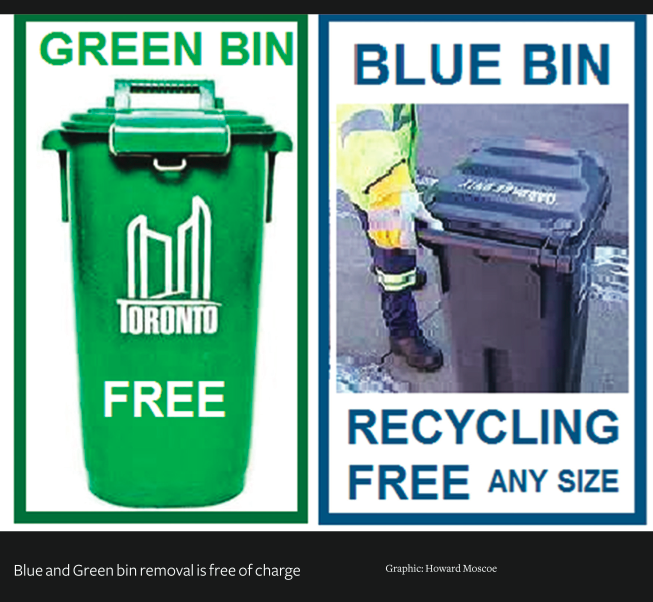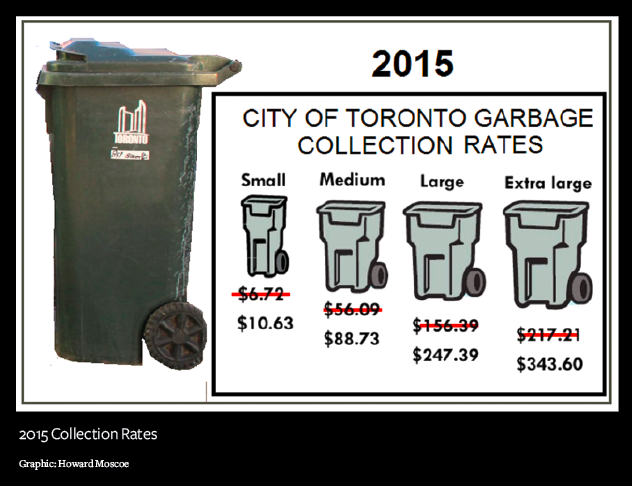By Howard Moscoe
By now most of us are active participants in the City’s waste collection system. The City of Toronto has trained several million of us to carefully separate our garbage intro three containers, green, grey and blue and dutifully haul it to sidewalk in accordance with a complex schedule for curbside collection by city trucks.
We routinely scrape food waste off our plates into a kitchen catcher which empties into a green bin. We sort our recyclable materials into a blue bin and toss what is left, the garbage, into a grey box which we drag to the curb and pay to have hauled away.
It wasn’t always that way. In the 1970s, everything was collected at the curb from a single garbage can and tossed into a big hole in the ground. The city called it a landfill site but most of us referred to it as “the dump”.
Keele Valley
The crisis came in the late 70’s. The city’s landfill sites were filling up. Bear Road in Pickering was scheduled to close and while the city had purchased Keele Valley, a worked out gravel pit, located in Vaughan North of Major Mackenzie drive and west of Keele Street for $37M It was becoming next to impossible to establish a new landfill site in Ontario. Rural areas were being urbanized and while new suburban residents wanted their garbage hauled away; they didn’t want it anywhere near where they lived.
Keele Valley opened up in November of 1983. Trucks had dumped more than 28 million tons of waste into its bowels. Vaughan residents celebrated its closing by cracking open a bottle of Champaign on New Year’s eve 2002. Keele Valley was entangled in law suits and if it was proposed under today’s environmental regulations could never have been approved.
Toronto was stuck. After 2002 there was no place to put Toronto’s garbage. Nobody wanted it. It was next to impossible to find another site.
Adams Mine
In August 2000 Toronto approved a plan, supported by the Harris Government, that would see Toronto’s garbage loaded onto trains, carried north to Kirkland Lake and dumped into a worked out iron mine, the Adams mine.
The outrage was crushing. By October the matter was re-opened at Toronto Council.
I remember the three days of debate. The council chamber was filled with angry residents of Northern Ontario and the opposition was led by Toronto Councillor Jack Layton.
I voted with the majority of Toronto council to kill the Adams Mine proposal.
Michigan
We had no option left. From 2002 to 2007 the city was forced, at an enormous expense, to haul its Garbage to landfill sites in Michigan where environmental regulations were weak and the waste disposal lobby was strong.
That meant some 90 giant garbage hauling trucks traveling 360 kilometers a day along the 401 through Windsor and Sarnia to two landfill sites in Michigan.
Pressure in the US to close the border to Canadian Garbage was growing along with opposition from the Canadian towns and cities through which the trucks rumbled.
Green Lane – A Stroke of Good Luck
On April 2, 2007 the City of Toronto was fortunate to be able to purchase an existing landfill site near London Ontario. It was an already approved 310 acre rural sitea large enough to handle 13.9M tons of Toronto’s waste.
Here’s the rub. The economy of the site depends on the efficiency of our efforts to recycle.
If Toronto can divert 42% of the waste from landfill Green Lane will fill up after 17 years and have to close by 2024.
If we can get our diversion rate up to 70% we can make it last for 28 years until 2035. Our collective efforts will determine when the next crisis comes.
That’s why the City of Toronto trained us to re-cycle, and that’s why it switched to a user pay system.
In 2008 the city took garbage removal off your property tax bill and transferred the cost to your utility bill.
It had to create a system that rewarded re-cycling. Recycling and wet waste are hauled away free of charge. You only pay to have your garbage removed and that cost is determined by the size of the bin.
The more you recycle the less trash you have, and the smaller and less costly your garbage removal becomes. Below are the new yearly rates you pay for garbage collection, which were increased this year.
You can avoid the increase and save money by changing to a smaller bin and it becomes even easier because the city has added a new range of plastics to the blue bin.
Want to change? It’s easy. Simply telephone 311 and tell them that you want to decrease the size of your grey bin. They will deliver the new bin to your house and take away the larger one free of charge. That will lower your utility bill.
Be cautious, however because the City will only downsize your bin free of charge. If you decide later that you want to go back and increase the size of the bin not only will you increase the size of the utility bill but you will be charged the cost of the new larger bin.




